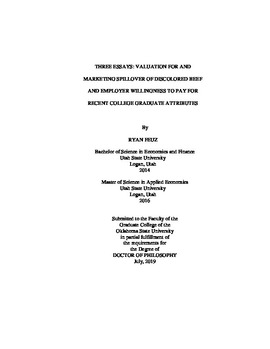| dc.contributor.advisor | Norwood, F. Bailey | |
| dc.contributor.author | Feuz, Ryan | |
| dc.date.accessioned | 2020-01-30T15:03:04Z | |
| dc.date.available | 2020-01-30T15:03:04Z | |
| dc.date.issued | 2019-07 | |
| dc.identifier.uri | https://hdl.handle.net/11244/323343 | |
| dc.description.abstract | This dissertation is comprised of two essays focusing on discoloration in retail beef, with the third essay evaluating the value to employers of recent college graduate attributes. | |
| dc.description.abstract | Consumers prefer beef to be bright cherry-red. As beef becomes discolored we expect consumers are willing to pay less for it. The first study's objective is to determine the willingness-to-pay (WTP) for varying levels of discoloration within both beef steak and ground beef relative to non-discolored beef. Two types of discoloration are considered: coverage (percent of surface area discolored) and intensity (the darkness of the discoloration). The estimated WTP discounts can be useful to retailers as they attempt to minimize losses associated with discolored beef. | |
| dc.description.abstract | The second study continues with the theme of discolored beef. Whereas the first study was concerned with the value of the discolored beef, the second study focuses on the value of and preferences for non-discolored beef when marketed together with discolored beef. It is plausible that marketing discolored beef alongside non-discolored beef may have a spillover effect on the value of the non-discolored beef. This study is concerned with determining if a spillover effect exists and determining the direction of the effect. | |
| dc.description.abstract | The third study is unrelated to the first two essays. In this essay we introduce a new method of stated preference valuation called design valuation. This method operates by defining a general good as a collection of attributes and assigning prices to those attributes. Respondents are then asked to design their optimal good based on selecting any combination of those attributes. By varying the attribute prices within and across surveys, the value of each attribute can be inferred. We apply the design valuation method to accomplish the purpose of this study which is to estimate the value employers place on various college graduate attributes. We add to the literature on recent college graduate attribute valuation by further classifying attribute values by employer type. Four employer type classifications are used; those that prefer to hire graduates from an agricultural, business, engineering, or other college. | |
| dc.format | application/pdf | |
| dc.language | en_US | |
| dc.rights | Copyright is held by the author who has granted the Oklahoma State University Library the non-exclusive right to share this material in its institutional repository. Contact Digital Library Services at lib-dls@okstate.edu or 405-744-9161 for the permission policy on the use, reproduction or distribution of this material. | |
| dc.title | Three Essays: Valuation for and Marketing Spillover of Discolored Beef and Employer Willingness to Pay for Recent College Graduate Attributes | |
| dc.contributor.committeeMember | Peel, Derrel S. | |
| dc.contributor.committeeMember | Riley, John Michael | |
| dc.contributor.committeeMember | Ramanathan, Ranjith | |
| osu.filename | Feuz_okstate_0664D_16343.pdf | |
| osu.accesstype | Open Access | |
| dc.type.genre | Dissertation | |
| dc.type.material | Text | |
| dc.subject.keywords | academic advising | |
| dc.subject.keywords | beef color | |
| dc.subject.keywords | beef discoloration | |
| dc.subject.keywords | non-market valuation | |
| dc.subject.keywords | willingness-to-pay | |
| thesis.degree.discipline | Agricultural Economics | |
| thesis.degree.grantor | Oklahoma State University | |
